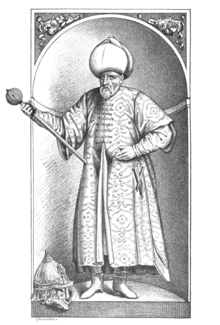
Back صقللي محمد باشا Arabic Sokollu Mehmed Paşa Azerbaijani Мехмед Соколу Bulgarian সোকোল্লু মেহমেদ পাশা Bengali/Bangla Mehmed-paša Sokolović BS Sokollu Mehmed Paixà Catalan Mehmed Paša Sokolović Czech Sokollu Mehmed Pascha German Σοκολού Μεχμέτ Πασάς Greek Sokollu Mehmet Bajá Spanish
Sokollu Mehmed | |
|---|---|
 | |
| 35th Grand Vizier of the Ottoman Empire | |
| In office 28 June 1565 – 11 October 1579 | |
| Sultan | Suleiman I Selim II Murad III |
| Preceded by | Semiz Ali Pasha |
| Succeeded by | Semiz Ahmed Pasha |
| Personal details | |
| Born | Bajica Nenadić 1505 Rudo, Sanjak of Herzegovina, Ottoman Empire (modern-day Rudo, Bosnia and Herzegovina) |
| Died | 11 October 1579 (aged 72–73) Constantinople, Ottoman Empire (modern-day Istanbul, Turkey) |
| Spouse | |
| Children | Safiye Hanımsultan Sultanzade Ahmed Bey Sultanzade Sokolluzâde Ibrahim Pasha Sultanzade Piri Mehmed Bey |
| Alma mater | Enderun School |
| Religious affiliation | Islam (prev. Eastern Orthodoxy) |
| Military service | |
| Allegiance | |
| Branch/service | |
| Years of service | 1541–1579 |
| Rank | Commander of the Imperial Guard (1543–1546) Kapudan Pasha (Grand Admiral; 1546–1551) Governor-General of Rumelia (1551–1555) Third Vizier (1555–1561) Second Vizier (1561–1565) Grand Vizier (1565–1579) |
| Battles/wars | Ottoman–Venetian War (1570–73) Ottoman–Hungarian Wars Russo-Crimean War (1571) Croatian-Ottoman Wars Ottoman–Safavid War (1532–55) Ottoman–Safavid War (1578–90)[1] |
Sokollu Mehmed Pasha (Ottoman Turkish: صوقوللى محمد پاشا, romanized: Sokollu Mehmet Paşa; Serbian Cyrillic: Мехмед-паша Соколовић, romanized: Mehmed-paša Sokolović; pronounced [měxmet pâʃa sokǒːloʋitɕ];[2] 1505 – 11 October 1579) was an Ottoman statesman of Serb origin most notable for being the Grand Vizier of the Ottoman Empire. Born in Ottoman Herzegovina into an Orthodox Christian family, Mehmed was recruited as a young boy as part of so called "blood tax" to serve as a janissary to the Ottoman devşirme system of recruiting Christian boys to be raised as officers or administrators for the state.[3] He rose through the ranks of the Ottoman imperial system, eventually holding positions as commander of the imperial guard (1543–1546), High Admiral of the Fleet (1546–1551), Governor-General of Rumelia (1551–1555), Third Vizier (1555–1561), Second Vizier (1561–1565), and as Grand Vizier (1565–1579, for a total of 14 years, three months, 17 days) under three sultans: Suleiman the Magnificent, Selim II, and Murad III.[4] He was assassinated in 1579, ending his near 15-years of service to several Sultans, as sole legal representative in the administration of state affairs.[4]
Although Sokullu was Muslim, he remembered his Serbian Orthodox roots and his family. He persuaded the Sultan to restore the Serbian Patriarchate of Peć as a "gesture of reconciliation".[5] He appointed members of his family (both Muslim and Christian) to important positions in Ottoman Empire, including Sokollu Mustafa Pasha, Makarije Sokolović, Ferhad Pasha Sokolović, Sinan-beg Boljanić, Sokolluzade Lala Mehmed Pasha and Lala Mustafa Pasha.[6]
- ^ Sicker 2001, pp. 2–3.
- ^ Mehmed/Мехмед in isolation: [měxmed].
- ^ Andric, Ivo (1945). The Bridge on the Drina. Dereta. ISBN 978-86-7346-819-8.
- ^ a b Imamović, Mustafa (1996). Historija Bošnjaka. Sarajevo: BZK Preporod. ISBN 9958-815-00-1
- ^ Cite error: The named reference
Judahwas invoked but never defined (see the help page). - ^ Sefik Peksevgen (21 May 2010). "Sokollu family". Encyclopedia of the Ottoman Empire. pp. 535–6. ISBN 9781438110257.